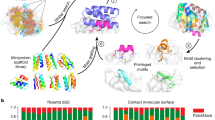Abstract
A protein design strategy was developed to specifically enhance the rate of association (kon) between a pair of proteins without affecting the rate of dissociation (koff). The method is based on increasing the electrostatic attraction between the proteins by incorporating charged residues in the vicinity of the binding interface. The contribution of mutations towards the rate of association was calculated using a newly developed computer algorithm, which predicted accurately the rate of association of mutant protein complexes relative to the wild type. Using this design strategy, the rate of association and the affinity between TEM1 β-lactamase and its protein inhibitor BLIP was enhanced 250-fold, while the dissociation rate constant was unchanged. The results emphasize that long range electrostatic forces specifically alter kon, but do not effect koff. The design strategy presented here is applicable for increasing rates of association and affinities of protein complexes in general.
This is a preview of subscription content, access via your institution
Access options
Subscribe to this journal
Receive 12 print issues and online access
$189.00 per year
only $15.75 per issue
Buy this article
- Purchase on Springer Link
- Instant access to full article PDF
Prices may be subject to local taxes which are calculated during checkout




Similar content being viewed by others
References
Shoup, D. & Szabo, A. Biophys. J. 40, 33–39 (1982).
Berg, O.G. & von Hippel, P.H. Annu. Rev. Biophys. Biophys. Chem. 14, 131–160 ( 1985).
Schreiber, G. & Fersht, A.R. Nature Struct. Biol. 3, 427–431 (1996).
Shi, Y.Y. et al. Protein Eng. 6, 289–295 (1993).
Schreiber, G., Buckle, A.M. & Fersht, A.R. Structure. 2, 945– 951 (1994).
Lee, F.S., Auld, D.S. & Vallee, B.L. Biochemistry. 28, 219– 224 (1989).
Harel, M., Kleywegt, G.J., Ravelli, R.B., Silman, I. & Sussman, J.L. Structure. 3, 1355–1366 (1995).
Radic, Z., Kirchhoff, P.D., Quinn, D.M., McCammon, A. & Taylor, P. J. Biol. Chem. 37, 23265–23277 (1997).
Getzoff, E.D. et al. Nature 358, 347–351 (1992).
Davis, M.E., Madura, J.D., Luty, B.A. & McCammon, A.J. Comput. Phys. Commun. 62, 187–197 ( 1991).
Kozack, U.E., d'Mello, M.J. & Subramanian, S. Biophys. J. 68, 807–814 (1995).
Madura, J.D. et al. Comput. Phys. Commun. 91, 57– 95 (1995).
Gabdoulline, R.R. & Wade, R.C. Biophys. J. 72, 1917–1929 (1997).
Zhou, H.X., Wong, K.Y. & Vijayakumar, M. Proc. Natl. Acad. Sci. USA 94, 12372–12377 (1997).
Vijayakumar, M., et al. J. Mol. Biol. 278, 1015– 1024 (1998).
Selzer, T. & Schreiber, G. J. Mol. Biol. 287, 409–419 (1999).
Strynadka, N.C.J., Jensen, S.E., Alzari, P.M. & James, M.N. Nature Struct. Biol. 3, 290–297 (1996).
Strynadka, N.C.J. et al. Nature. 368, 657–660 (1994).
Albeck, S. & Schreiber, G. Biochemistry. 38, 11–21 (1999).
Gilson, M.K. & Honig, B.A. Nature 330, 184–186 (1987).
Schindler, P. & Huber, G. In Enzyme inhibitors. (ed. Brodbeck, U.) 169–176 (Verlag Chemie, Weinheim; 1980).
Guex, N. & Peitsch, M.C. Electrophoresis 18 , 2714–2723 (1997).
Schreiber, G. & Fersht, A.R. Biochemistry 32, 11195–11203 (1993b).
Stone, R.S., Dennis, S. & Hofsteenge, J. Biochemistry 28, 6857– 6863 (1989).
Nicholls, A. GRASP: graphical representation and analysis of surface properties (Columbia University, New York; 1992).
Acknowledgements
G.S. holds the Dewey David Stone and Harry Levine career development chair. This research was supported by a research grant from the Crown endowment fund for immunological research. We thank J. Sussman and A. Horovitz for their critical reading of the manuscript.
Author information
Authors and Affiliations
Corresponding author
Rights and permissions
About this article
Cite this article
Selzer, T., Albeck, S. & Schreiber, G. Rational design of faster associating and tighter binding protein complexes . Nat Struct Mol Biol 7, 537–541 (2000). https://doi.org/10.1038/76744
Received:
Accepted:
Issue Date:
DOI: https://doi.org/10.1038/76744
This article is cited by
-
Study on the S239D/I332E mutation effect on the kinetics of Fc–Fc receptor binding through transition complex theory
Biotechnology and Bioprocess Engineering (2024)
-
A biomimetic electrostatic assistance for guiding and promoting N-terminal protein chemical modification
Nature Communications (2022)
-
Influence of temperature and salt on coacervation in an aqueous mixture of poly-L-lysine (PLL) and poly-(sodium styrene sulfonate) (PSSNa)
European Biophysics Journal (2021)
-
KD determination from time-resolved experiments on live cells with LigandTracer and reconciliation with end-point flow cytometry measurements
European Biophysics Journal (2021)
-
Structure-based design and discovery of novel anti-tissue factor antibodies with cooperative double-point mutations, using interaction analysis
Scientific Reports (2020)



